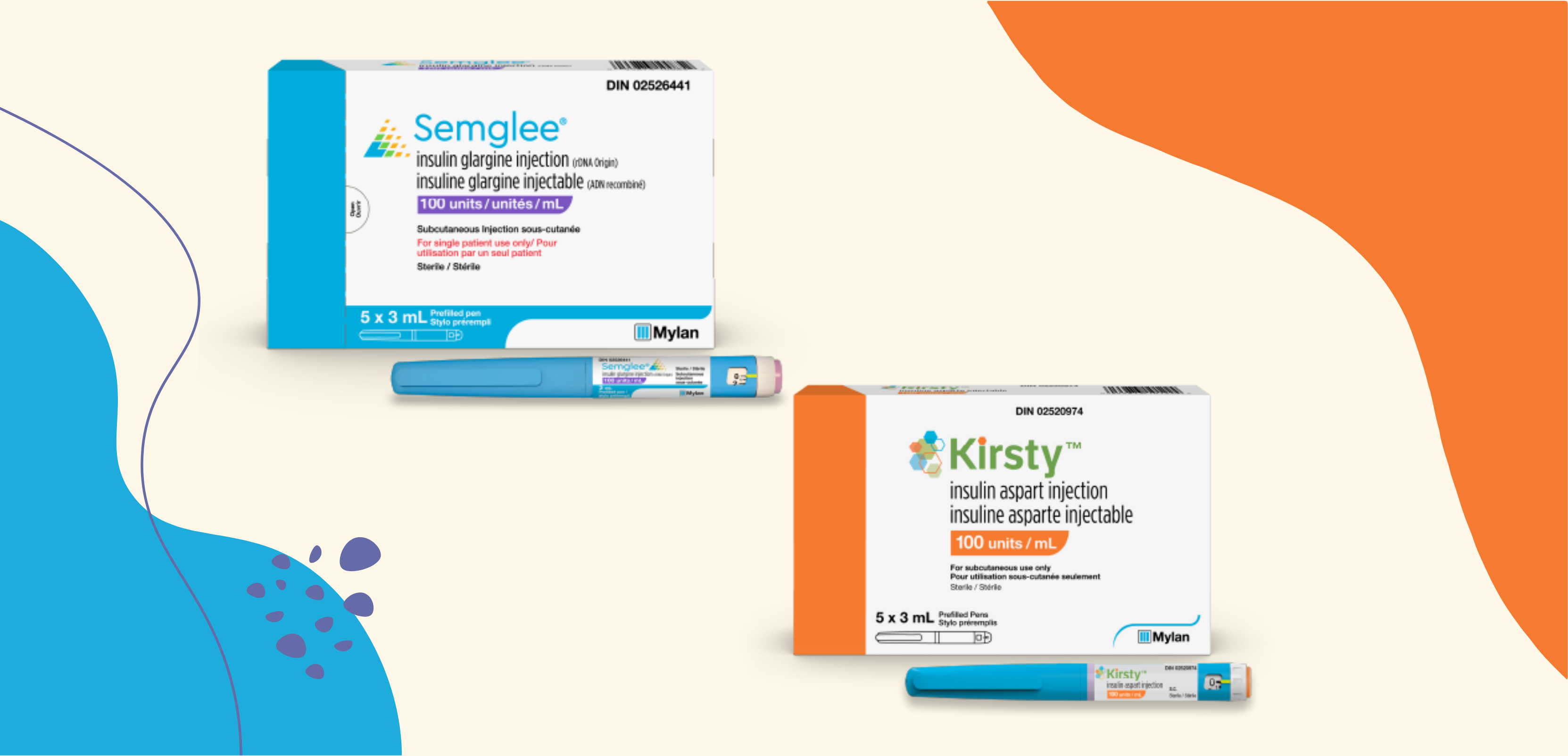Reference insulin products are increasingly being replaced with biosimilar types of insulin.
Until recently, three biosimilar insulin products were available in Canada:
- Admelog, biosimilar version of Humalog
- Trurapi, biosimilar version of Novorapid
- Basaglar, biosimilar version of Lantus
Biosimilar insulin products, just like generic products, are a “copy” of a reference drug. The main difference between the two types is how this “copy” is created.
Biosimilar drugs (e.g., insulin) are made using living cells (e.g., bacteria), while generic drugs are derived from a chemical synthesis process (e.g., generic acetaminophen tablets).
Regardless of how they are manufactured, both generic and biosimilar products are nearly identical “copies” of an original product that have undergone a thorough validation process to verify that they have the same efficacy (e.g., lowering blood sugar levels) and safety features (e.g., risk of hypoglycemia).
Governments and private insurers tend to favour biosimilar types of insulin, since they are more affordable than original products. In fact, in some provinces such as Quebec, reference types of insulin are no longer covered, pushing patients to switch to the equivalent biosimilar product.
Two new biosimilar insulin products, Viatris’ Kirsty and Semglee, were recently made available in Canada.
Kirsty, the new biosimilar version of Novorapid
Kirsty was approved in October 2021; this rapid-acting insulin is the second biosimilar version of Novorapid (along with Trurapi insulin). But it was only recently that the manufacturer decided to make this insulin available on the Canadian market.
This new product is currently available only in pre-filled pens (DIN: 02520974). According to the company, the vials will be available on the market in the second half of 2023 for use in insulin pumps.
It should be noted that since the pan-Canadian Pharmaceutical Alliance (pCPA) did not authorize the manufacturer to negotiate the purchase price, Kirsty is not included in provincial biosimilar substitution programs. Pharmacies are therefore free to charge whatever amount they wish for this new insulin.
Semglee, the new biosimilar version of Lantus
Approved in April 2022, Semglee became the second biosimilar version of Lantus (original insulin), with Basaglar already available. This new long-acting insulin is currently available only in pre-filled pens (DIN: 02526441).
Price negotiations for Semglee have recently been completed, so provincial government and private insurance coverage should be announced shortly.
It is very likely that the biosimilar substitution programs will offer both Semglee and Basaglar as alternatives to Lantus.
Lowering the cost of insulin: for whose benefit?
Thanks to a much simpler development process, the introduction of biosimilar insulin products on the market has helped to lower the cost of insulin. Will the arrival of new biosimilar products for the same reference insulin allow for even lower costs? Who will benefit from a potential price decrease, people with diabetes or governments?
This is likely to depend heavily on price negotiations with provincial governments. A price decrease could result in a lower cost of purchase for T1D patients, but if the manufacturer negotiates a price comparable to the price of other biosimilars while offering a discount to governments under a private agreement, the cost for T1D patients would remain the same while the governments benefit from reduced healthcare costs.
We will have to wait and see how this plays out. Hopefully, these new types of drugs will reduce the overall cost of insulin for people with diabetes.
How will this work?
The arrival of these new biosimilar insulin products also raises the question of the role of pharmacists. Will they be able to interchange biosimilar products? And what if none of the biosimilar products are suitable for a patient? Will they be able to get the original insulin?
Switching to a new insulin, whether it’s a copy or not, is anything but simple. The patient has to get used to a new pen, deal with new worries and paperwork, etc. Although studies have found no difference between biosimilar and original versions, some people with T1D have reported decreased effectiveness.
It should also be noted that these new types of insulin are available only in disposable pens, which are sometimes of lower quality and not well liked by patients. They also work against patients’ waste reduction goals.
Ultimately, people with T1D should indisputably be able to use the insulin that is right for them and have their healthcare team’s support.
References :
- Alliance pancanadienne pharmaceutique, consulté le 15 novembre 2022, https://www.pcpacanada.ca/fr
- Kirsty (insulin aspart), Alliance pancanadienne pharmaceutique, consulté le 15 novembre 2022, https://www.pcpacanada.ca/negotiation/21631
- Semglee (insulin glargine), Alliance pancanadienne pharmaceutique, consulté le 15 novembre 2022, https://www.pcpacanada.ca/negotiation/21887?fbclid=IwAR35XTlI9GiG7eREHmsnHP3pgwSXjPK07o2X3pkc5mhWoj0z1POgMggu35g
- Sommaire des motifs de décision – Semglee – Santé Canada, Gouvernement du Canada, https://hpr-rps.hres.ca/reg-content/sommaire-motif-decision-detailTwo.php?linkID=SBD00600&fbclid=IwAR1iSXImsCTk-wsA5nxYeEpYxsnPhD1L7iJZPntgBnhGVmf2ql_KHKxCInA

Written by: Sarah Haag RN. BSc.
Reviewed by:
- Amélie Roy-Fleming Dt.P., EAD, M.Sc.
- Rémi Rabasa-Lhoret, MD, PhD
- Claude Laforest, Laurence Secours, Jacques Pelletier, Alec Courchesne, Nathalie Kinnard, Marie-Christine Payette, Michel Dostie, patient-partners of the BETTER project
Linguistic revision by: Marie-Christine Payette
Participate in the BETTER registry!

First registry of people living with T1D in Canada.
Learn More








